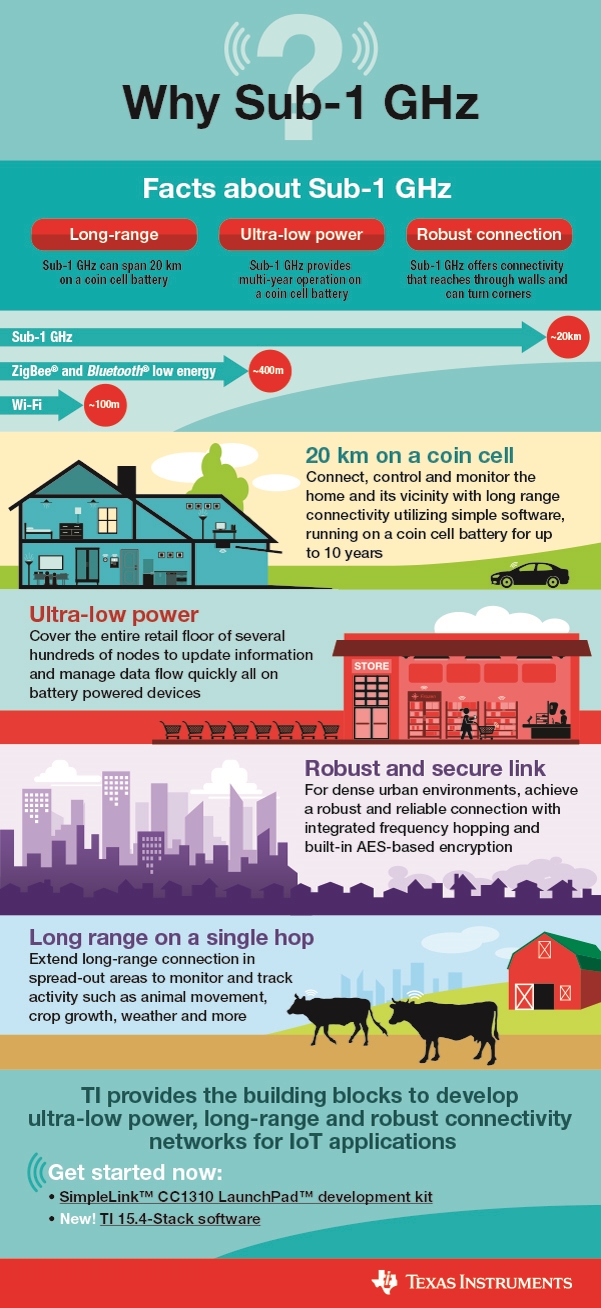SSZTB26 july 2016 CC1310
We continue to see tremendous growth within the Internet of Things (IoT) market with more devices than ever being connected to the cloud.
With applications such as home automation, which allow you to equip your home with lighting, heating, and alarm systems that give you the ability to turn on lights, set a desired temperature and receive notifications of any alarm activity right on your mobile device as soon as you approach the drive way.
The ability to connect low-power devices to the cloud is possible today with a number of different wireless connectivity technologies. The question often becomes which wireless technology is the right one for your application.
Communication over the Sub-1 GHz band has the unique ability of providing the longest range and lowest-power consumption with overall link robustness.
Long Range
- Half the frequency gives twice the range: The lower the frequency the longer the range. The attenuation is proportional to the wave length allowing lower frequencies, like Sub-1 GHz, to be able to travel further than higher frequencies.
- Provides full house and vicinity coverage: Sub-1 GHz has better penetration capabilities than 2.4 GHz as the attenuation through objects, such as walls, increases with frequency. Also, lower frequencies are better at “turning corners” providing increased indoor coverage.
- Narrowband capability: Sub-1 GHz solutions can operate in a narrowband mode, decreasing the probability of interference and increasing range due to improved link budget.
Robustness
- Avoid crowded bands: Compared to the 2.4 GHz band, which is crowded with Bluetooth®, ZigBee® and Wi-Fi®, the Sub-1 GHz ISM bands are mostly used for low duty-cycle links and are less likely to interfere with each other.
- Less susceptible to interference: Sub-1 GHz solutions can operate in a narrowband mode, decreasing the probability of interference.
- Frequency hopping: With the TI 15.4-Stack software, you are able to achieve longer range in the FCC band and offer better protection against in-band interference by implementing frequency hopping.
Ultra-low Power
- Lower power than other technologies: You can achieve the same range in Sub-1 GHz than 2.4 GHz with less transmit power. This enables Sub-1 GHz to be a very viable solution for battery-powered applications. For example, the SimpleLink™ Sub-1 GHz CC1310 wireless microcontroller (MCU) offers one of the lowest power consumptions in the industry.
- Multi-year operation on a coin cell battery: Sub-1 GHz operates in a quieter environment which means that the reception is less likely to be disturbed by other transmitters, resulting in less retries and hence improving the battery lifetime.
- 20 km on a coin cell battery: Sub-1 GHz is the only technology capable of covering whole houses with simple software compared to Bluetooth®, ZigBee® and Wi-Fi®which results in overall lower power consumption.
Figure 1 is an infographic highlighting the key benefits of using a Sub-1 GHz technology for your IoT network.
 Figure 1 Reasons why you should use Sub-1 GHz in your IoT applications.
Figure 1 Reasons why you should use Sub-1 GHz in your IoT applications.Get Started Developing Today!
- Order the CC1310 wireless MCU LaunchPad™ development kit
- Download the TI 15.4-Stack software development kit
Additionally Resources:
- Learn more about TI’s Sub-1 GHz solutions: www.ti.com/sub1ghz
- Read more about our new TI 15.4-Stack software in this blog post
- Find out more about TI's role in the IoT: www.ti.com/iot
- Watch our ‘Why Sub-1 GHz?’ training video
- Download our latest white paper on frequency hopping
- Also, check out some of our CC1310 wireless mcu-based TI Design reference designs:
- Humidity & Temp Sensor Node for Sub-1 GHz Star Networks Enabling 10+ Year Coin Cell Battery Life (TIDA-00484)
- Low Power Wireless PIR Motion Detector Reference Design Enabling 10 Year Coin Cell Battery Life (TIDA-00489)
- Energy Harvesting Ambient Light and Environment Sensor Node for Sub-1 GHz Networks Reference Design (TIDA-00488)